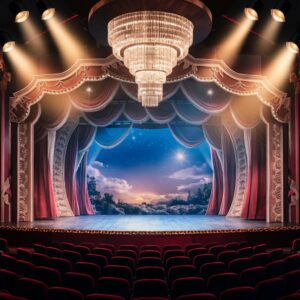Since the dawn of organized entertainment, stage design has been a cornerstone of theatrical and live performance. The craft has continuously evolved from ancient Greek amphitheaters to today’s immersive virtual environments, adapting to technological advancements and changing artistic philosophies. This article explores the journey of stage design and highlights key milestones that have shaped its development.
entertainment, stage design has been a cornerstone of theatrical and live performance. The craft has continuously evolved from ancient Greek amphitheaters to today’s immersive virtual environments, adapting to technological advancements and changing artistic philosophies. This article explores the journey of stage design and highlights key milestones that have shaped its development.
Ancient Beginnings: Functional Simplicity
In ancient Greece, theater was an essential aspect of cultural life. Performances were often held in large, open-air amphitheaters. The backdrop of these stages was typically a permanent architectural structure known as the “skene,” which provided a neutral yet functional setting. These structures were simple, often adorned with minimalistic decorations that relied heavily on the audience’s imagination.
In ancient Rome, stage design was slightly improved with elaborately painted curtains and props. However, the primary focus remained on the actors and the spoken word, with design elements serving as subtle support rather than a central feature.
The Renaissance: The Birth of Perspective
The Renaissance brought a paradigm shift in stage design, driven by advancements in art and architecture. Italian theaters introduced perspective painting, creating the illusion of depth on flat surfaces. Designers like Sebastiano Serlio pioneered techniques that transformed two-dimensional backdrops into visually dynamic environments.
Proscenium arches became popular during this period, framing the stage and enhancing the sense of depth. This era also saw the development of moveable scenery, allowing designers to change settings quickly and provide audiences with more visually engaging experiences.
The 19th Century: Realism and Spectacle
The 19th century marked the rise of realism in theater. Designers like Adolphe Appia and Edward Gordon Craig revolutionized stagecraft by emphasizing three-dimensional sets and dynamic lighting. Appia’s designs, for example, rejected flat-painted backdrops in favor of architectural forms that interacted with light and shadow, creating a more immersive environment.
This period also witnessed the advent of mechanical stage technology. Revolving stages, trapdoors, and elaborate pulley systems allowed more complex scene changes and heightened dramatic effects. The emphasis shifted toward creating a world on stage as believable as the stories being told.
The 20th Century: Experimentation and Innovation
The 20th century was a time of experimentation in both form and function. Modernist movements such as Expressionism and Constructivism influenced stage design, encouraging abstraction and symbolic representation. Designers like Josef Svoboda and Robert Edmond Jones embraced multimedia, integrating projections, film, and sound into their sets.
The rise of digital technology in the late 20th century further expanded the possibilities. Computer-generated imagery (CGI) and automated lighting systems enabled designers to create dynamic, ever-changing environments that could adapt in real-time to the needs of a performance.
The 21st Century: The Age of Immersion
In the 21st century, stage design has entered the realm of virtual and augmented reality. VR and AR technologies allow for fully immersive environments that blur the line between physical and digital spaces. Productions like The Tempest by the Royal Shakespeare Company have used these technologies to create breathtaking, otherworldly visuals that respond dynamically to performers.
Projection mapping is another groundbreaking innovation. It enables designers to transform any surface into a canvas for moving images. Combined with advanced sound design, these techniques create multisensory experiences that engage audiences in unprecedented ways.
The Future: Endless Possibilities
As technology advances, the future of stage design promises even greater innovation. Artificial intelligence, interactive audience participation, and holographic imagery are just a few of the areas poised to redefine the theatrical experience. The integration of sustainable practices is also gaining momentum, with designers exploring eco-friendly materials and energy-efficient technologies.
Evolution in Design
The evolution of stage design reflects humanity’s innate desire to tell stories in compelling and visually stunning ways. From the simplicity of ancient backdrops to the immersive worlds of virtual reality, each era has pushed the boundaries of what is possible, enriching the art of performance. As we look to the future, stage design will undoubtedly continue to inspire and captivate, merging art and technology in ever more innovative ways.
